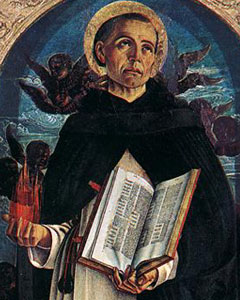Saint Vincent Ferrer
 April 5: St. Vincent Ferrer
April 5: St. Vincent Ferrer
St. Vincent Ferrer was born in Valencia, Spain, in the mid-1300s to parents known for their virtue and almsgiving.
Vincent entered the Dominican Order n 1367. He received his doctorate at Catalonia, followed by five years of preaching at the Cathedral at Valencia. A brilliant student and ardent member of the Dominican Order, he was chosen as prior of the Dominican house in Valencia shortly after his ordination.
When Vincent entered the Dominican Order, it was the time of the Great Schism – the Church’s division under multiple popes. From 1378 to 1417, two (and later three) men claimed to be the legitimate pope, each with his own following. They included Cardinal Pedro de Luna, who set up a papal court in Avignon in 1394 and named himself Benedict XIII. He offered Vincent many Church positions, even that of cardinal, which Vincent refused. The only role he took was that of de Luna’s confessor.
Vincent campaigned fruitlessly to end the schism and, after four years, left to become a missionary. He spent the next 20 years preaching throughout Europe about sin, death, God’s judgments, and eternity. Vincent’s sermons were so powerful that many people returned to their Catholic faith. Though Vincent spoke only his native Spanish, people of all languages were able to understand what he said. His biographers believe he had the ability to speak in tongues to communicate the word of God.
When Vincent lay dying, he saw a vision of Christ, St. Francis of Assisi, and St. Dominic. As a result of this vision, he was miraculously cured. He began preaching about the last judgment and the need for penance. Because of this, Vincent came to be known as the “angel of judgment.”
Vincent Ferrer died at the age of 69 from a fever. He had asked for the Passion of Christ to be read from all four Gospels at his funeral, because it was the Wednesday before Palm Sunday, April 5, 1419.
Vincent’s favorite saying was, “Whatever you do, think not of yourselves, but of God.”
Saint Vincent Ferrer was canonized in 1455. He is the patron saint of brick makers, builders, construction workers, plumbers, and tile makers.









